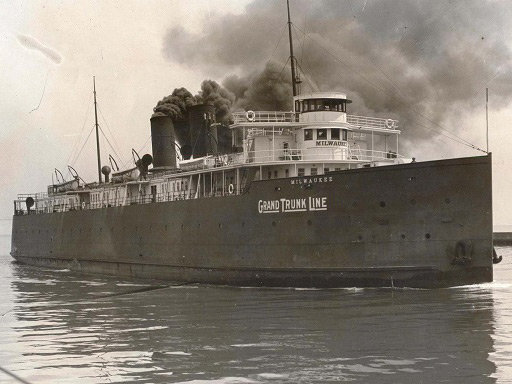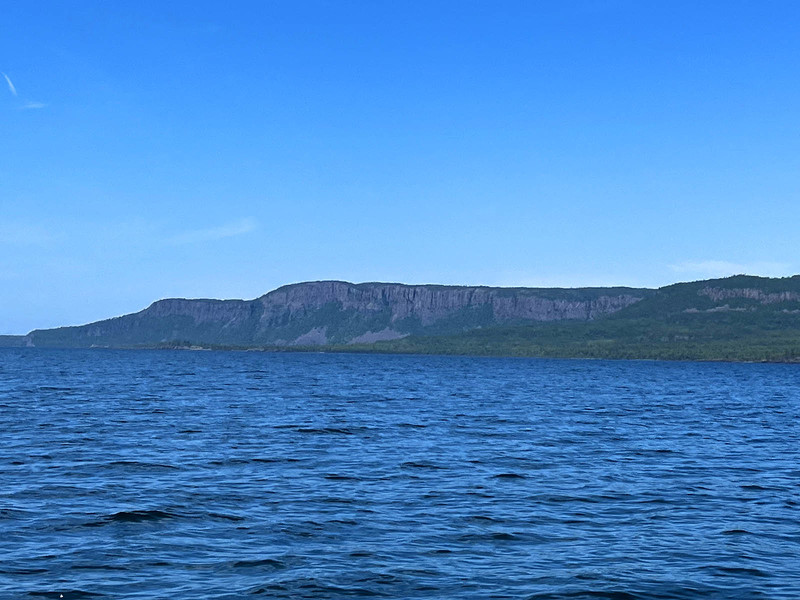Fans of Milwaukee – and Great Lakes – history who haven’t signed up for the Wisconsin Marine Historical Society’s mailing list are missing out.
The group – headquarted at Milwaukee Public Library, which I featured in this story a few years back – is very active in terms of collecting and archiving documents and photos and objects and also hosts numerous events each year.
The newsletter is an easy way to find a cool old photo in your inbox every week (sometimes more). And, because these folks are history buffs like the rest of us, there’s always a story behind the photo and the WMHS folks share that story.
On Oct. 22, 1929, Grand Trunk Line car (that’s railroad cars) ferry MILWAUKEE went missing during one of those fearsome storms for which Lake Michigan has long been well known.
Here’s the rest of the story, courtesy of the folks at the Wisconsin Marine Historical Society:
She had no radio. Two days later, wreckage was discovered near Racine, Wisconsin. Soon after, two bodies were recovered further south. On Oct. 27, a message tube was found near Holland, Michigan, with a note purportedly from the ship’s purser describing a desperate situation. About 50 men were on board when the boat left port. None survived. MILWAUKEE’s final resting place remained a mystery until 1972 when a team of divers located the wreckage. It lies in about 120 feet of water seven miles northeast of Milwaukee and three miles offshore. Today, it is a popular dive site for advanced divers.
MILWAUKEE was built for the Manistique Marquette and Northern Railroad by American Ship Building at its Cleveland yard. Launched as the MANISTIQUE MARQUETTE & NORTHERN I, she entered service in 1903 sailing between Michigan’s upper and lower peninsulas at Manistique and Northport. Designed by Robert Logan, she was nearly identical to another of his boats, PERE MARQUETTE 18, built one year earlier. At 338 feet long with a 56-foot beam and a steel hull, MANISTIQUE MARQUETTE & NORTHERN I carried up to 30 rail cars on her four tracks.
In 1903, Captain Edward Crosby began ferrying rail cars for the Grand Trunk railroad between Milwaukee and Grand Haven, Michigan. Crosby had financial difficulties and the railroad took over ferry operations in 1905. Needing additional capacity, the Grand Trunk acquired the MANISTIQUE MARQUETTE & NORTHERN I in 1908 and renamed her MILWAUKEE. For many years she served the Grand Trunk faithfully.
"While the greater part of Wisconsin was in winter’s icy grip Tuesday night, Lake Michigan was lashed by a furious storm, declared the worst in years." In Milwaukee, waves driven by winds that reached 52 miles per hour wrecked the floating clubhouse of the South Shore Yacht Club. Storm warnings had been posted Tuesday morning, Oct. 22, and the Pere Marquette ferries did not leave Milwaukee that day.
But the Grand Trunk ferries sailed. The MILWAUKEE arrived from Grand Haven about noon. Captain Robert "Bad Weather" McKay did not find the passage particularly difficult. So MILWAUKEE discharged her cargo and took on 27 loaded freight cars. At about 3 o'clocl that afternoon she left Milwaukee’s harbor. 45 minutes later she passed Lightship 95 anchored about 3 miles offshore. She was rolling and pitching heavily. That was the last anyone saw or heard from the MILWAUKEE. She was not equipped with radio.
Even though more than 24 hours overdue, there was hope. A second Grand Trunk ferry, the GRAND RAPIDS, left Milwaukee four hours after her fleet mate. Following the same route as the MILWAUKEE, the GRAND RAPIDS finally made Grand Haven after more than 21 hours. Her crew reported a very difficult crossing. None had seen the MILWAUKEE or any wreckage.
On Thursday, Oct. 24, the steamer COLONEL reported wreckage off Wind Point lighthouse four miles north of Racine. However, there was nothing that indicated it was from the MILWAUKEE. But early that afternoon, the STEEL CHEMIST radioed: "Picked up two bodies of seamen eleven miles off Kenosha. Both bore life belts from the MILWAUKEE. Watch on one of the bodies stopped at 9:35. Sailing east." A little while later, the STEEL CHEMIST recovered a deckhouse and other wreckage. She then continued on to Chicago. It appeared the MILWAUKEE had foundered six hours after steaming out of Milwaukee’s harbor.
In Grand Haven, two unidentified children visited the Grand Trunk lines office. Believed to be around 10 and 12 years old, they asked whether it was true that two bodies had been found. Curious, the agent inquired as to why they asked. The children replied: "Well, our daddy is on that boat."
On Friday, Oct. 25, coastguardsmen from St. Joseph, Michigan, found a lifeboat from the MILWAUKEE. The open boat was discovered mid lake about 40 miles from St. Joseph. It was half submerged and contained four bodies. All had died of exposure.
On Sunday, Oct. 27, a message canister washed ashore near Holland, Michigan. It contained a brief note on stationary of the Grand Trunk line. Dated Oct. 22 at 6:30 p.m. and signed by A.R. Sadon, purser, it read: "The ship is taking water fast. We have turned around and headed for Milwaukee. Pumps are working but sea gate is bent in and can’t keep the water out. Flicker is flooded. Seas are tremendous. Things look bad. Crew roll is about the same as last payday."
According to the last company payroll, there were 59 men in the crew. At least four missed the boat. Believing that even "Bad Weather" McKay would not sail given the conditions, three men went to a movie. A fourth was sent into the city with a message and returned after the ferry had left. It is generally believed that about 50 men perished when the MILWAUKEE went down. Only 15 bodies were recovered.
The body of Captain McKay was found and identified. He was 67 years old and had 50 years of service on the Great Lakes. He was made master of the MILWAUKEE two years prior. McKay had planned to retire at the end of the year and settle down at his home in Grand Haven. After surviving many storms on the Lakes, this one he couldn’t beat.
A 26-year veteran when she foundered, the MILWAUKEE had recently been overhauled. As built, she did not have a seagate. While not watertight, the seagate acts as a barrier that prevents following seas from rushing over the car deck. The ANN ARBOR 5, launched in 1910, was the first Lake Michigan railroad car ferry equipped with a seagate. The MILWAUKEE was retrofitted with a four-foot gate. But this was almost five feet lower than those on newer ferries like the GRAND RAPIDS, which survived the storm.
Given the purser’s note, authorities believed the MILWAUKEE had turned back. Now with a following sea and the lake in a very agitated state, it was speculated that water flooded over the seagate eventually overwhelming the pumps. This doomed the MILWAUKEE and her crew. In response, new regulations required all cross-lake ferries to have a seagate at least eight and one-half feet high.
For more than 40 years Lake Michigan hid the remains. Most believed the MILWAUKEE had been blown south of her intended course and sank near Kenosha. Fishermen told of snagging lines on something off Fox Point (north of Milwaukee). While heading for Two Rivers in April 1972, a dive team decided to check the area. They quickly located a large target. It was the MILWAUKEE.
Located about seven miles northeast of Milwaukee and three miles offshore, the wreck sat upright and showed considerable damage. Wooden deckhouses were gone and the steel seagate was "twisted like a pretzel." Exploration was slow. At 120 feet, divers could only spend about 20 minutes at a time on the wreck. In the pilothouse, which laid about 75 feet from the hull, divers found a pocket watch. It had stopped at 7:05. On the car deck, several loaded freight cars had broken loose.
The MILWAUKEE and her contents were insured. The ferry was valued at $250,000, freight cars at $60,000, and merchandise at $100,000. This allowed the Grand Trunk to order a replacement almost immediately. Built by Manitowoc Shipbuilding and completed in 1931, the new boat would be named CITY OF MILWAUKEE. Very similar to her predecessor, the CITY OF MILWAUKEE sailed until 1982. She is preserved as a National Historic Landmark museum in Manistee, Michigan.
NOTES:
Captain Edward G. Crosby founded the Crosby Transportation Company and later started ferry service for the Grand Trunk railroad. He was aboard the TITANIC on her maiden voyage in 1912 and died when she went down after striking an iceberg.
In 1918, the federal Railroad Administration assumed control of the Lake Michigan car ferries. At this time, the boats received radio sets. These were removed when the ferries were returned to their owners in 1920.
The Associated Press version of Sadon’s note, which appeared in several newspapers, reads: "Making water fast in slicker. Pumps working good. Have turned back to Milwaukee, might make it, might not. All crew same as on last pay roll." The original note was found at the Chicago branch of the National Archives in 2006.
A lifeboat from the MILWAUKEE is on display outside the 1860 Lighthouse and Light Station Museum in Port Washington.
The Goodrich steamer WISCONSIN battled the Oct. 22 storm. Coming up from Chicago, she arrived at Milwaukee 12 hours late and with a noticeable list. According to her skipper, Captain D.H. Morrisson, the storm was the worst he had been called upon to weather in his 26 years on the Great Lakes. Seven days later, the WISCONSIN would be at the bottom and Captain Morrisson dead.
Sign up for the Wisconsin Marine Historical Society’s email newsletter by emailing wmhs@wmhs.org.
Born in Brooklyn, N.Y., where he lived until he was 17, Bobby received his BA-Mass Communications from UWM in 1989 and has lived in Walker's Point, Bay View, Enderis Park, South Milwaukee and on the East Side.
He has published three non-fiction books in Italy – including one about an event in Milwaukee history, which was published in the U.S. in autumn 2010. Four more books, all about Milwaukee, have been published by The History Press.
With his most recent band, The Yell Leaders, Bobby released four LPs and had a songs featured in episodes of TV's "Party of Five" and "Dawson's Creek," and films in Japan, South America and the U.S. The Yell Leaders were named the best unsigned band in their region by VH-1 as part of its Rock Across America 1998 Tour. Most recently, the band contributed tracks to a UK vinyl/CD tribute to the Redskins and collaborated on a track with Italian novelist Enrico Remmert.
He's produced three installments of the "OMCD" series of local music compilations for OnMilwaukee.com and in 2007 produced a CD of Italian music and poetry.
In 2005, he was awarded the City of Asti's (Italy) Journalism Prize for his work focusing on that area. He has also won awards from the Milwaukee Press Club.
He has be heard on 88Nine Radio Milwaukee talking about his "Urban Spelunking" series of stories, in that station's most popular podcast.







